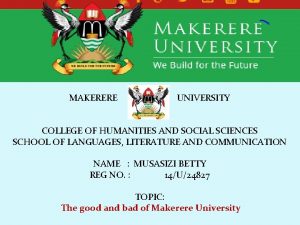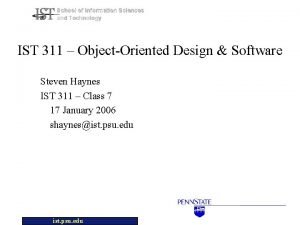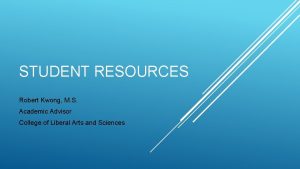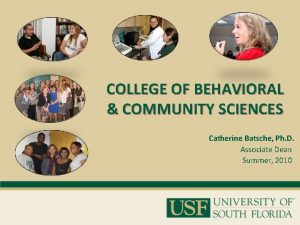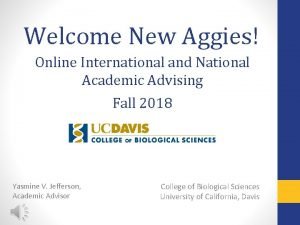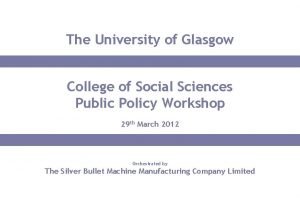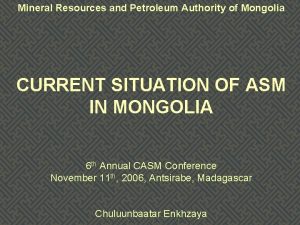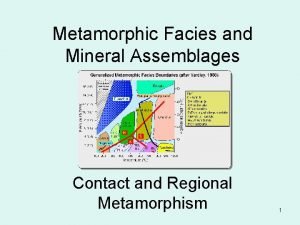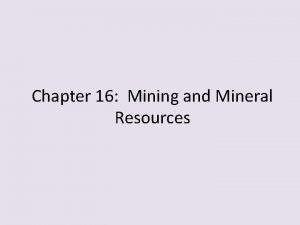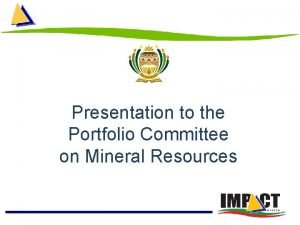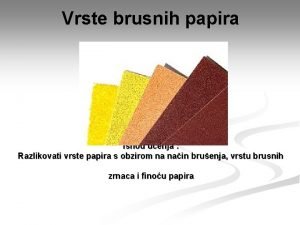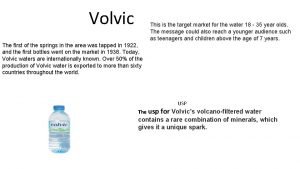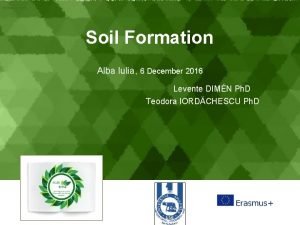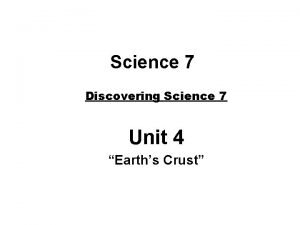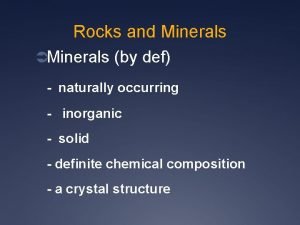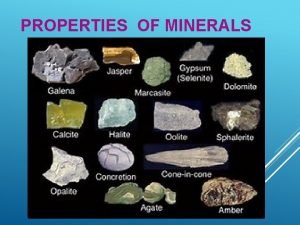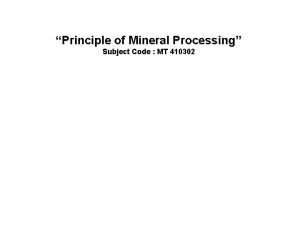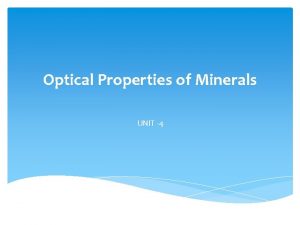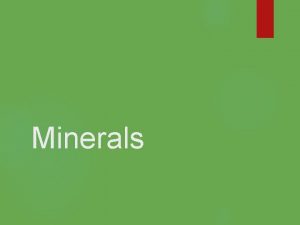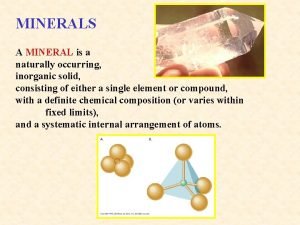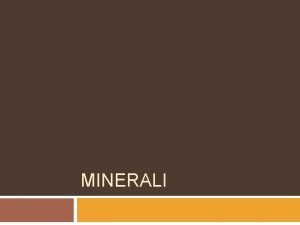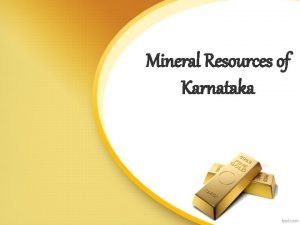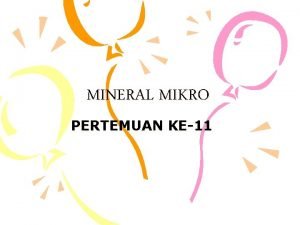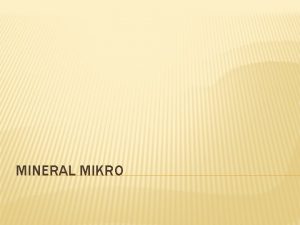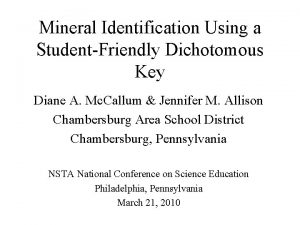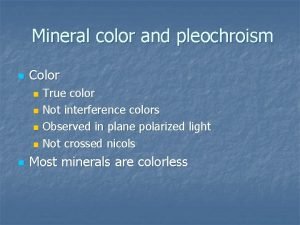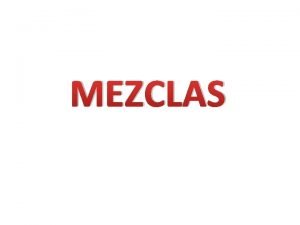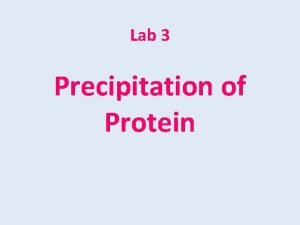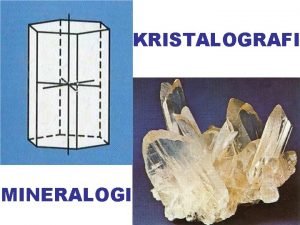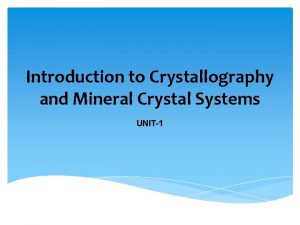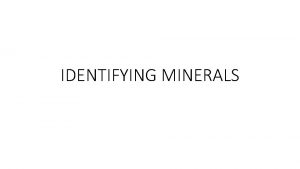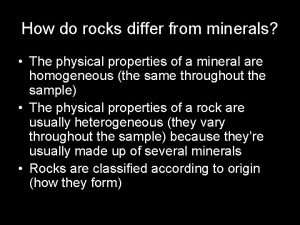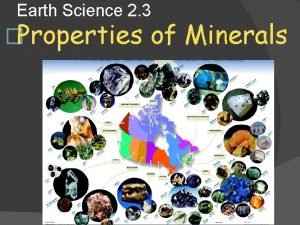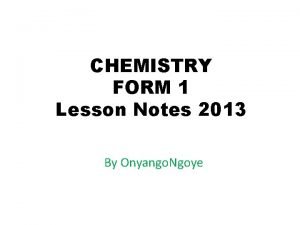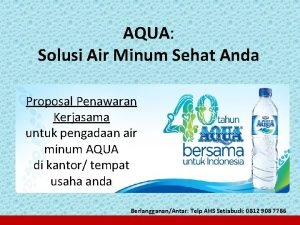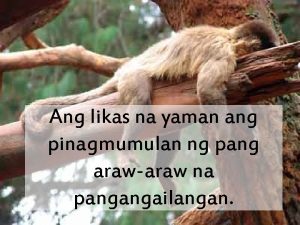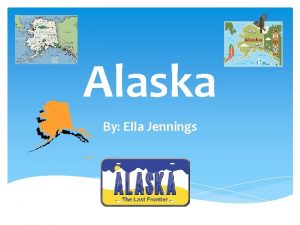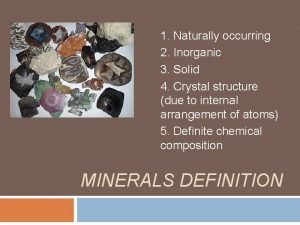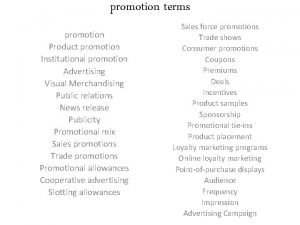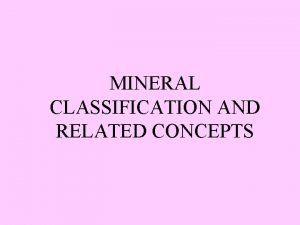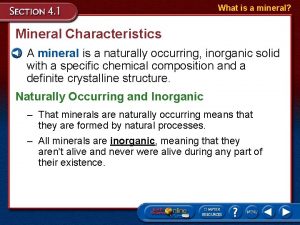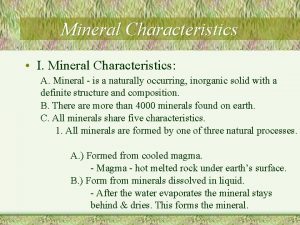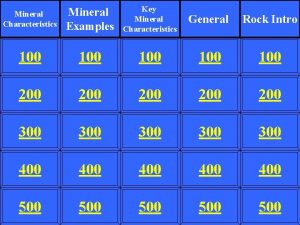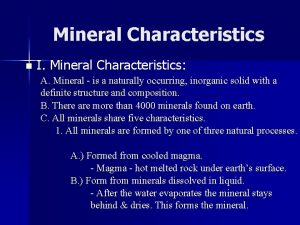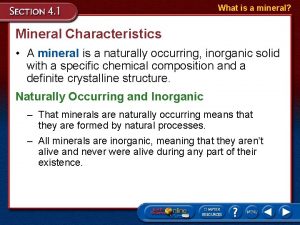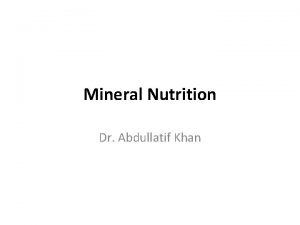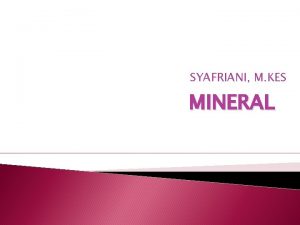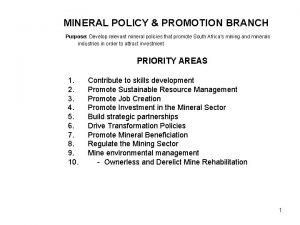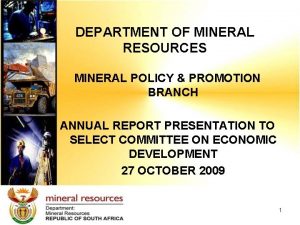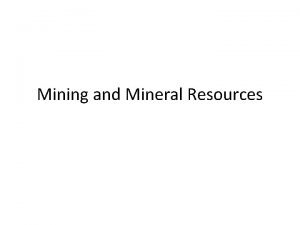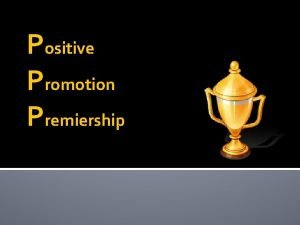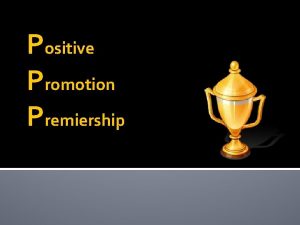College of Earth and Mineral Sciences Promotion and















































- Slides: 47

College of Earth and Mineral Sciences Promotion and Tenure 1

Overview • • • Informational Resources (where to go to get info) Activity Insight EMS Promotion and Tenure (P&T) Committee 2020/2021 Expectations for P&T PSU’s P&T Process • Major Criteria • The Dossier • • The 4 Sections Research Grants Narrative Statement External Evaluators • Dossier Review Schedule • Other Items Promotion and Tenure 2

Informational Resources • Your department head and administrative staff member(s) • • • EME – Judi Hite Geog – Marnie Deibler Geo. Sci – Amy Homan Mat. SE – Peg Yetter Meteo – Jennifer Renoe • The Dean’s Office • Rosie Long, 863 -4643, rkl 1@psu. edu • John Barlett, 867 -5072, jvb 102@psu. edu Promotion and Tenure 3

Informational Resources (cont. ) • College and Department Criteria Statements • Faculty Mentor • Frequently Asked Questions about Promotion and Tenure from the Vice Provost for Academic Affairs website • Penn State Policy AC-23 • Penn State Administrative Guidelines for AC-23 • EMS Dossier Template (plus detailed instructions) • All web resources together on the EMS Faculty Promotion and Tenure Page: https: //www. ems. psu. edu/resources-faculty-and-staff then click the Promotion and Tenure accordion block Promotion and Tenure 4

Activity Insight EMS has transitioned to Activity Insight for building our dossiers Activity Insight is an online software tool by Digital Measures designed to help faculty members collect, organize, and display their data for the purposes of annual reviews, promotion and tenure, and more. It is a centrally funded resource that is aimed at providing an easier, more efficient way for colleges and campuses to manage large reporting processes in a less time-consuming fashion. Promotion and Tenure 5

Activity Insight (cont. ) Each Department in EMS is now using AI If you have any questions or need any assistance, please reach out to your departmental P&T rep Promotion and Tenure Screen shot of homepage 6

Earth and Mineral Sciences - University Park Promotion & Tenure Committee 2020/2021 • Derek Elsworth, Distinguished Professor of Energy and Mineral Engineering • Alex Klippel, Professor of Geography • Donald Fisher, Professor of Geosciences • Tze-Chiang (Mike) Chung, Professor of Materials Science and Engineering • Jerry Harrington, Professor of Meteorology and Atmospheric Science (Chair) Promotion and Tenure 7

Process for Promotion to Associate Professor or Professor and for Tenure Process begins in early summer • The department head (in conjunction with the candidate) assembles a package to be sent to external evaluators • The department head (as delegated by the Dean) gathers a list of potential external evaluators from the department committee, other faculty members (as needed), and the candidate and submits to the Dean • The Dean then approves a list to be contacted • The majority of the evaluators should NOT come from the candidate’s list Promotion and Tenure 8

Timing • 2 nd and 4 th year reviews are standard practice • 3 rd and 5 th year reviews may be conducted to aid faculty members who need further guidance or, for some 5 th year reviews, early tenure • Early tenure requests require prior approval from the Dean, Vice Provost and Provost • Final tenure review (and promotion) are in the 6 th year • For specific dates, please consult your department representative Promotion and Tenure 9

Dossier Preparation Candidates are urged to take special care in assembling the factual information of the dossier. • Information must be arranged strictly in order as defined by AC 23 (Activity Insight system will ensure proper formatting) • Activity Insight is being used for our tenure-eligible faculty dossier preparation. If candidates use the system in the 2 nd & 4 th year reviews, by the time they get to the 6 th year, their dossiers should be in great shape • The standardized format facilitates the review process, helping to ensure equitable review for all Promotion and Tenure 10

Expectations for P&T Briefly, EMS’s expectations are: To Associate Professor - Demonstrated, through scholarly achievements and evaluations by both students and peers, the potential to become an outstanding scholar of national renown and an accomplished, inspiring teacher To Professor – be an established, internationally recognized scholar and superior teacher Promotion and Tenure 11

The Major Criteria The three major criteria for both tenure and promotion include: • Teaching • Research & Scholarly Accomplishments • Service The critical measure in the evaluation will be the individual's impact on science and/or industry and higher education, that is, the impact on students, colleagues, departmental programs, and fields of specialization. The aim is to promote and reward those who excel in their academic work and who by their dedication and performance serve to uphold or enhance our reputation as a distinguished College. Promotion and Tenure 12

Section 1: TEACHING For promotion to the following ranks, the successful candidate, depending upon their rank, will: Associate: have the potential to be an accomplished, inspiring teacher, as demonstrated through scholarly achievements and evaluations by both students and peers Professor: be a superior teacher Promotion and Tenure 13

A. Measures of TEACHING Effectiveness Teaching effectiveness is measured by: A. the record of SRTE results and a summary of student comments (from the SRTE survey); Note: Pursuant to the COVID-19 suspension of SRTEs and peer reviews in Spring 2020, faculty who do not include any of the alternative documentation of teaching effectiveness for spring 2020 semester cannot be penalized for not including them. B. the effective direction of doctoral studies of graduate students, postdoctoral scholars, master’s students, undergraduate advising and of undergraduate research; and C. peer evaluations of teaching and evaluations by the Department Head (or Associate Dept Head) NOTE: For Promotion to Professor, teaching history can only go back 10 years or to their last promotion, whichever is most recent Promotion and Tenure 14

Section 2: RESEARCH For promotion to the following ranks, the successful candidate must: Associate: “have demonstrated, through scholarly achievements … the potential to become an outstanding scholar of national repute” Professor: “be an established, internationally recognized scholar…” Promotion and Tenure 15

Measures of RESEARCH Effectiveness This status will be measured: 1. Partly by external review letters; 2. Partly by publications (especially in peer-reviewed journals) and recognition; and 3. Partly by research grants/external funding (for those whose disciplines have these) External Review Letters should not come from close colleagues nor from hostile colleagues … inform your department head or Dean of either category Promotion and Tenure 16

Measures of RESEARCH Effectiveness (cont. ) a. Publication of research results in the highest-quality peer-reviewed journals or other publication media in the appropriate discipline(s) b. A record of external research funding indicating that the candidate will be able to provide a sufficient level of support for his or her future research efforts c. A record of invited talks at major academic institutions, industrial and governmental laboratories, and major conferences d. Other accomplishments demonstrating that the candidate is, or has the potential to become, a globally recognized researcher Promotion and Tenure 17

Section 3: SERVICE For promotion, the successful candidate will have demonstrated a continuing record of service to the university, to society, and to the profession Promotion and Tenure 18

Measures of SERVICE effectiveness a. Appropriate levels of service to the department, the college, the university, and to the scientific community must be maintained. A list of activities is usually sufficient b. Exceptional accomplishments should be noted NOTE: For Promotion to Professor, service history can only go back 10 years or to their last promotion, whichever is most recent Promotion and Tenure 19

Narrative Statement • Candidates should include a narrative statement indicating their sense of their teaching, research, and service activities • The Statement should be no longer than 3 single-spaced pages and is to provide the faculty member with the opportunity to place their work and activities in the context of their overall goals (e. g. , what’s important to the discipline, how will your goals benefit students). It should not repeat what is in the dossier • The narrative statement appears just before the Teaching dossier divider Promotion and Tenure 20

Narrative Statement (cont. ) • Should not exceed 1, 600 words (if using Activity Insight, do not adjust the margins) • Is written in the first person in non-technical language • Provides a context and focus for the dossier • Candidates should be encouraged to use the narrative to place their work and activities into their overall goals and agendas • It should be factual and objective Promotion and Tenure 21

Section 4: External Evaluator Letters • This section of the dossier is highly confidential and can only be viewed & discussed by: • • • Departmental P&T Committee Department Head College Committee Dean Provost University Committee This section will be removed from the dossier if the candidate asks to view the dossier at any time Promotion and Tenure 22

Packages for External Evaluators • External Evaluators are provided: • Current Curriculum Vitae • A research statement, similar to the narrative statement, but without the teaching and service components • Copies of 5 -7 selected publications • May include “Accepted” publications (when substantiated by letter of acceptance) • They are NOT provided the entire dossier at any time • They will NOT evaluate the teaching and/or service of the candidate, only the research portion Promotion and Tenure 23

Selection of External Reviewers • External reviewers are chosen from a list of possibilities submitted by the candidate and another list compiled by the department head, usually in consultation with senior faculty in the field • It is best if the preponderance of external evaluators not be names that appeared solely on the list compiled by the faculty member • After the department head selects their list, a copy of the list is sent to the dean’s office for the dean’s approval • No contact between the candidate and evaluator is permitted • For candidates who work in more than one area, it is important to pick evaluators from each area of expertise Promotion and Tenure 24

Questions Asked of External Evaluators • In what capacity, if any, do you know Dr. Doe? If you have had interactions with him/her, please describe the context of these interactions • Do the quality and quantity of Dr. Doe’s published work justify the personnel action being considered by our Department of (name)? Would you recommend him/her for promotion and tenure in your own department? Promotion and Tenure 25

Questions Asked of External Evaluators (cont. ) • How significant a scientific impact has Dr. Doe made upon his/her field of specialization? Can you identify any genuinely major contributions Dr. Doe has made to (enter field)? For tenure cases only - • If tenure is granted to Dr. Doe and they remain on our faculty for the duration of their professional career, is it likely that their presence will significantly elevate the quality and reputation of our department, or will their presence be more likely to maintain the department at its present level of excellence? Promotion and Tenure 26

Required Statement on External Evaluator Request Letters For tenure cases only - • There is a required statement concerning stays of tenure, which must be included in solicitation letters: “The time period for achieving tenure and promotion to associate professor can vary, including one or more extensions of the tenure clock. A faculty member who stops the tenure clock must be evaluated according to the number of years on the tenure clock, not the number of years since being hired. The faculty member should not be held to a standard higher than the one he/she would have had to meet if the tenure decision had been made in the year it was originally scheduled. ” Promotion and Tenure 27

Important Procedural Note • The last date to add factual information to a dossier is February 1 st (please note, this is a change from previous years) • Any information added after the department committee has met requires that the entire dossier must travel again through every level of review. Therefore, late additions are discouraged unless they are of major significance Promotion and Tenure 28

Dossier is built … now what? Promotion and Tenure 29

Dossier Review Schedule • Except for 2 nd Year, dossiers are reviewed and recommendations made by: • Department committee (mid-October) • Department head (mid- to late November) • College committee (mid-January to early February) (do not normally review 4 th year dossiers – only when Dean requests) • Dean (February) • For 6 th Year and Early Tenure only • University committee (March-April) • Provost/President (end of April) Promotion and Tenure 30

2 nd Year Dossier Review Schedule • Reviewed and recommendations made by: • Department committee (mid-January to mid. February) • Department head (mid-February to mid-March) • College committee (usually N/A) • Dean (mid-March to April) Promotion and Tenure 31

2 nd & 4 th Year Reviews Provide: detailed information to the candidate about which areas of the criteria may require special attention as the candidate moves toward final tenure review Purpose: to ensure communication is flowing and provide a formal evaluation and feedback on the path towards tenure One-on-One Review: after process complete, the department head provides the candidate with copies of the current year’s evaluative statements (written by the Department P&T, the Department Head, the College P&T (except for 2 nd Year Reviews and, under normal circumstances, 4 th Year Reviews), and the Dean) and meets with the candidate to discuss them. Promotion and Tenure 32

3 rd and 5 th Year Reviews If deemed necessary, the Dean or department head can request a special 3 rd and/or 5 th year review to assist the candidate by providing additional guidance and feedback and, in some cases, to recommend early tenure Early tenure reviews are generally done in the 5 th year, but can be done as early as the 3 rd year. Prior approval from the Dean and Provost is required Promotion and Tenure 33

Other Possible Outcome Another possible outcome of a 2 nd, 3 rd, 4 th, 5 th or 6 th year review is termination This is extremely rare Promotion and Tenure 34

Other Items n n Stopping the Clock Confidentiality Candidate’s Responsibilities COVID-19 Impacts to P&T Promotion and Tenure 35

Stopping the Clock • The Tenure Clock stops automatically when the candidate is on leave without pay for more than one half of the contract year • The Clock may also be stopped (this is called “staying of the provisional tenure period”) by request of the candidate in relation to some extenuating circumstance, such as the birth or adoption of a child, placement of a foster child in the home, a serious personal illness or provision of care for a family member • To request a stay, the faculty member must make the request in writing to the department head, providing the justification • The request should be submitted in a timely fashion, as close to the qualifying event as possible Promotion and Tenure 36

Stopping the Clock (cont. ) • Please note, the candidate should not mention anything about the reason for the stay/stopping of the clock in their dossier • The request is reviewed by the department head, the dean, and the executive vice president and provost, who grants final approval • A stay is granted for one academic year (candidate may only request up to a maximum of two years during the period leading up to tenure) Promotion and Tenure 37

Confidentiality • Essential to the process • Responsibility of everyone involved to support this basic tenet • Candidates should not prod committee members or administrators … and … committee members and administrators should not divulge information to candidates, or anyone, through words, innuendos, or gestures • It is expected that both the candidate and the committee members will adhere to the confidentiality of the promotion and tenure process • Confidentiality extends into the future; it is forever! Promotion and Tenure 38

Candidate Responsibilities • Aid their Department Head in the construction of an accurate and thorough dossier • Write a narrative statement that places their work and activities into the context of their overall goals and agendas • Provide inputs on potential external evaluators • Sign the appropriate signatory statement in the dossier • Start working on the ‘meat’ of their dossier on day 1! • NOTE: if a tenure-eligible faculty member does not submit a dossier, withdraws it, or fails to comply with AC 23, the faculty member will have voluntarily resigned from their tenure-eligible appointment and will be terminated on 30 June Promotion and Tenure 39

COVID-19 Impacts • Where can I find out more about the extension to the probationary period due to COVID-19, including whether I’m eligible? • The extension of the probationary period due to COVID-19 applies to any faculty member in the probationary period in spring 2020. More information about the extension to the probationary period due to COVID-19 can be found in the administrative guidelines (Page 26, VII) and in the FAQs related to this guidance. (VII). • If a candidate takes the COVID-19 extension, will this be indicated on the P&T form? • The decision to take the COVID-19 extension will not be indicated on the P&T form. Promotion and Tenure 40

COVID-19 Impacts (cont. ) • Will the extension of the review period due to COVID-19 be mentioned in requests to reviewers? • While the extension of the probationary period due to COVID-19 is not a stay, the language pertaining to stays in request letters to external reviewers will be modified for those who were in the probationary period in Spring 2020 as indicated below. • “The time period for achieving tenure and promotion to associate professor can vary, including one or more extensions of the tenure clock. In Spring 2020, Penn State extended its tenure clock by one year in acknowledgement of the negative impacts of COVID-19. A faculty member must be evaluated according to the number of years on the tenure clock, not the number of years since being hired. The faculty member should not be held to a standard higher than the one he/she would have had to meet if the tenure decision had been made in the year it was originally scheduled. (Appendix C). Promotion and Tenure 41

COVID-19 Impacts (cont. ) • I am NOT going to confirm acceptance of the one-year extension to the probationary period due to COVID-19. Can I still submit a request for early tenure? • Yes. Approval must be sought in accordance with existing policies and guidelines for early tenure consideration. (See the “Guidelines for Recommending Faculty for Early Tenure” in Appendix H of the Administrative Guidelines. ) • What is the best way to indicate on Activity Insight/the Dossier how COVID-19 impacted our teaching, research, and service activities? • You may use your narrative statement to document how COVID-19 may have hindered or impacted your activities. You can also use the comment section to indicate, for example, that a presentation/paper was accepted but not delivered due to COVID-19. • May I list conference presentations that I was scheduled to deliver at meetings that were canceled due to COVID-19? • You may list your unattended conference presentations along with a comment that the presentation was “accepted but unable to be presented because of COVID-19. ” Promotion and Tenure 42

COVID-19 Impacts (cont. ) • During the COVID-19 crisis, teaching has been greatly influenced. If submitting a tenure package on time, how much will that influence the promotion decision? • During the spring 2020 semester, Penn State required faculty to convert all residential courses to remote delivery. The university suspended use of SRTEs and peer reviews for evaluation of teaching effectiveness given that the move to remote delivery affected faculty members in serious, consequential, and distinct ways. Faculty who do not include any of the alternative documentation of teaching effectiveness for spring 2020 semester cannot be penalized for not including them. Faculty candidates for promotion may wish to provide alternative documentation about their teaching in spring semester 2020. See Appendix M for recommended alternatives to document teaching activities in the spring 2020 semester. (II. C. 2). Promotion and Tenure 43

COVID-19 Impacts (cont. ) • While SRTEs will be administered in spring of 2020, results will not be available to academic administrators. May I still include my SRTEs for spring 2020 in my dossier? • Only courses taught will be automatically added to a faculty member’s Activity Insight record. SRTEs will not be included in Activity Insight for any faculty member. Some faculty may want to include their spring 2020 SRTEs in their promotion dossiers. However, the inclusion of spring 2020 SRTEs by some, but not others, compromises the spirit of equity and fairness because questions likely will be raised about why other faculty choose to omit them. As a result, it is recommended that only in the rarest of circumstances should a faculty member include them, such as if there is a specific need to demonstrate achievement in response to specific guidance for improvement. Promotion and Tenure 44

COVID-19 Impacts (cont. ) • How will peer teaching observations be handled for those going up formal review in fall of 2020? • Tenure-line (and non-tenure-line) faculty routinely undergo peer review of teaching and contribute to peer review of teaching committees. In acknowledgement of the COVID-19 crisis and its extraordinary impacts on our faculty, and, our collective shift to a remote learning environment, Penn State suspended peer review of teaching, as of March 16, for Spring semester 2020. (Appendix M). • I've had several class observations this semester for the fourth-year review that was to take place next academic year (2020 -2021). If my 4 th-year review takes place in the 2021 -2022 academic year instead, will these observation letters still be valid, or will they have to be redone? • The peer teaching observations you currently have will not need to be re-done. Please see Appendix M for a recommended alternative to a peer teaching observation. Promotion and Tenure 45

Review • Informational Resources (where to go to get info) • Expectations for P&T • EMS P&T Committee 2020/2021 • PSU’s Promotion and Tenure Process • Major Criteria • The Dossier • • The 4 Sections Research Grants Narrative Statement External Evaluators • Dossier Review Schedule • Other Items Promotion and Tenure 46

Questions? Promotion and Tenure 47
 Natural sciences tok
Natural sciences tok Ucf health sciences health promotion track
Ucf health sciences health promotion track College of humanities and social sciences
College of humanities and social sciences College of information sciences and technology
College of information sciences and technology Uf clas advisors
Uf clas advisors College of behavioral and community sciences
College of behavioral and community sciences Queens high school for the sciences at york college
Queens high school for the sciences at york college عبور2ثبت
عبور2ثبت College of social sciences glasgow
College of social sciences glasgow Mineral resources and petroleum authority of mongolia
Mineral resources and petroleum authority of mongolia Metamorphic facies and mineral assemblages
Metamorphic facies and mineral assemblages Chapter 13 mineral resources and mining
Chapter 13 mineral resources and mining Primary emulsion
Primary emulsion Mineral exploration and mining active reading
Mineral exploration and mining active reading Portfolio committee on mineral resources and energy
Portfolio committee on mineral resources and energy Wake tech admissions
Wake tech admissions Early college high school at midland college
Early college high school at midland college Tvrdi mineral za brušenje
Tvrdi mineral za brušenje Evian target audience
Evian target audience Showeet
Showeet Rock vs mineral
Rock vs mineral Minerals def
Minerals def Crystal shape
Crystal shape 2 product formula mineral processing
2 product formula mineral processing Resemisasi
Resemisasi Optical properties of minerals
Optical properties of minerals Veins are often formed from hot water solutions
Veins are often formed from hot water solutions Mineral vs element
Mineral vs element Mineral lojevec
Mineral lojevec Mineral resources of karnataka
Mineral resources of karnataka Mineral mikro
Mineral mikro Mineral mikro
Mineral mikro Lusteryes
Lusteryes What is the true color of mineral
What is the true color of mineral Destilacion fraccionada
Destilacion fraccionada Silicato
Silicato Precipitation of proteins by strong mineral acids
Precipitation of proteins by strong mineral acids Orthorombik
Orthorombik Tetragonal shape
Tetragonal shape Luster of minerals
Luster of minerals Origin
Origin Mica hardness
Mica hardness What does cleavage mean in minerals
What does cleavage mean in minerals Mineral acid examples
Mineral acid examples Contoh surat penawaran produk air mineral
Contoh surat penawaran produk air mineral Yamang likas na pinagmumulan ng isda
Yamang likas na pinagmumulan ng isda Alaska state nickname
Alaska state nickname Inorganic mineral definition
Inorganic mineral definition


